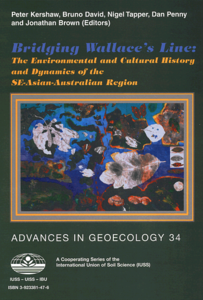From savannah to rainforest: changing environments and human occupation at Liang Lembudu, Aru Islands, Maluku (Indonesia)
O'Connor, Sue, Aplin, Ken P., Spriggs, Matthew, Veth, Peter, and Ayliffe, Linda K. (2002) From savannah to rainforest: changing environments and human occupation at Liang Lembudu, Aru Islands, Maluku (Indonesia). In: Kershaw, Peter, David, Bruno, Tapper, Nigel, Penny, Dan, and Brown, Jonathan, (eds.) Bridging Wallace's Line: the environmental and cultural history and dynamics of the SE-Asian-Australian region. Advances in Geoecology, 34 . Catena Verlag, GmbH, Ärmelgasse, Germany, pp. 279-306.
|
PDF (Published Version)
- Published Version
Restricted to Repository staff only |
||
![[img]](https://researchonline.jcu.edu.au/14359/2.hassmallThumbnailVersion/14359_Oconnor_et_al_2002_front_page.gif)
|
Image (GIF) (Front Cover)
- Cover Image
Download (136kB) |
Abstract
[Extract] The Aru Islands lie near the edge of the Australian continental shelf in the Arafura Sea, approximately 150 km south of the coast of Papua (fonner1y Irian Jaya). For at least the first 40,000 years of occupation of Sahul they formed part of a continuous land bridge linking Australia and New Guinea. During this time they would have been a dissected limestone plateau on the exposed Carpentarian Plain. About 14,000 years BP sea level rose and began to encircle the island group, separating it from Australia and by 11,500 years BP it was completely separated from New Guinea. The presence on Am of numerous marsupials, the cassowary and Birds of Paradise attest to this shared history, a fact first recognised by Darwin's co-discoverer of the theory of evolution by natural selection, the naturalist Alfred Russel Wallace (Wallace 1869).
While the waters to the east of the Aru Islands are relatively shallow, reflecting the previous land bridge with Papua and NW Australia, the continental shelf to the west descends steeply. Along most of the northwest coastline of the Am Islands the 100 m isobath is located as little as 10 km away (Figure 15.1). Recent research into sea level changes in the Australian region indicates that between 70,000 and 40,000 years BP sea level was between -50 and -90 m below its present position (Chappell 1994). This means that along most of the north and northwest coast of Australia the earliest evidence for colonisation will now be submerged and the earliest date for colonisation probably unknowable. Sites along the greater part of the present coastline may have been located up to 200 km inland at the time of their initial occupation. The steeply shelving offshore profile on the west coast of Aru makes it one of the few entry points into Sahul where evidence of early settlement is likely to be preserved.
| Item ID: | 14359 |
|---|---|
| Item Type: | Book Chapter (Research - B1) |
| ISBN: | 978-3-923381-47-0 |
| Keywords: | archaeology; eastern Indonesia; prehistory |
| Related URLs: | |
| Date Deposited: | 07 Dec 2010 05:27 |
| FoR Codes: | 21 HISTORY AND ARCHAEOLOGY > 2101 Archaeology > 210199 Archaeology not elsewhere classified @ 100% |
| SEO Codes: | 97 EXPANDING KNOWLEDGE > 970116 Expanding Knowledge through Studies of Human Society @ 100% |
| Downloads: |
Total: 194 Last 12 Months: 2 |
| More Statistics |



